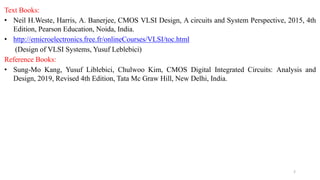
Module 1 VLSID Design flow - Copy.pptx
- 1. 2 Text Books: • Neil H.Weste, Harris, A. Banerjee, CMOS VLSI Design, A circuits and System Perspective, 2015, 4th Edition, Pearson Education, Noida, India. • http://emicroelectronics.free.fr/onlineCourses/VLSI/toc.html (Design of VLSI Systems, Yusuf Leblebici) Reference Books: • Sung-Mo Kang, Yusuf Liblebici, Chulwoo Kim, CMOS Digital Integrated Circuits: Analysis and Design, 2019, Revised 4th Edition, Tata Mc Graw Hill, New Delhi, India.
- 2. IntegratedCircuit-Moore’sLaw • Moore's law (In year 1975) is the observation that the number of transistors in an integrated circuit (IC) doubles about every two years. • Moore's law is an observation/empirical relationship and projection of a historical trend, rather than a law of physics. • The observation is named after Gordon Moore, the co-founder of Fairchild Semiconductor and former CEO of the Intel (Integrated Electronics). • The level of integration as measured by the number of logic gates in a monolithic chip has been steadily rising for almost three decades. Evolution of logic complexity in integrated circuits
- 3. • Less area/volume and therefore, compactness • Less power consumption • Less testing requirements at system level • Higher reliability, mainly due to improved on-chip interconnects • Higher speed, due to significantly reduced interconnection length • Significant cost savings IntegratedCircuit–DesignObjectives/Performancemetrics
- 4. VLSIDesignFlow-DesignPartitioning Flowchart of VLSI design flow Front end design (Involves gate level HDL-EDA tools) Back end design (Involves transistor level CAD tools) Architectural Design: User’s perspective, what does it do? Example: Instruction set, registers MIPS, x86, Alpha, PIC, ARM, … Functional Design Example: Single cycle, multcycle, pipelined, superscalar? Logic: how are functional blocks constructed Example: Ripple carry, carry lookahead, carry select adders Circuit: how are transistors used Example: Complementary CMOS, pass transistors, domino
- 5. 5 VLSIDesignFlow • The design process, at various levels, is usually evolutionary in nature. • It starts with a given set of requirements. Initial design is developed and tested against the requirements. • When requirements are not met, the design has to be improved. • If such improvement is either not possible or too costly, then the revision of requirements and its impact analysis must be considered.
- 6. • The Y-chart (first introduced by D. Gajski) shown in Figure illustrates a design flow for most logic chips, using design activities on three different axes (domains) which resemble the letter Y. • The Y-chart consists of three major domains, namely: • behavioral domain • structural domain • geometrical layout/Physical domain VLSIDesignFlow::Y-chart
- 7. • Although the design process has been described in linear fashion for simplicity, in reality there are many iterations back and forth, especially between any two neighboring steps, and occasionally even remotely separated pairs. • Although top-down design flow provides an excellent design process control, in reality, there is no truly unidirectional top-down design flow. Both top-down and bottom-up approaches have to be combined. VLSIDesignFlow
- 8. • The use of hierarchy, or “divide and conquer” technique involves dividing a module into sub- modules and then repeating this operation on the sub- modules until the complexity of the smaller parts becomes manageable. • This approach is very similar to the software case where large programs are split into smaller and smaller sections until simple subroutines, with well- defined functions and interfaces, can be written. • A hierarchy structure can be described in each domain (shown in Y-chart) separately. VLSIDesignHierarchy
- 10. VLSIDesignHierarchy:: Conceptsof Regularity,ModularityandLocality The VLSI design hierarchy mush take care/satisfy of the following concepts. Regularity: The hierarchical decomposition of a large system should result in not only simple, but also similar blocks, as much as possible. Regularity usually reduces the number of different modules that need to be designed and verified, at all levels of abstraction. Modularity: The various functional blocks which make up the larger system must have well-defined functions and interfaces. Locality: Internal details remain at the local level. The concept of locality also ensures that connections are mostly between neighboring modules, avoiding long-distance connections as much as possible.
- 11. VLSIDesignStyles • Standard IC • Application specific IC (ASIC) : Following are the various ASIC Design Styles
- 12. VLSIDesignStyles::full-custom In full-custom style, the designer has many degrees of freedom to optimize a circuit design: • Adjust individual transistor dimensions (channel width, channel length, aspect ratio, etc.) to satisfy: • DC specifications (voltage levels, switching thresholds) • Transient specifications (delay times, rise- and fall-times) • Freely choose the most appropriate topology (placement and routing) for each circuit block. • Decide for the interconnection strategy between neighboring blocks. • Decide for the global distribution of power, ground and clock.
- 13. VLSIDesignStyles::standardcell Each standard cell is pre-designed, with: • Same cell height for all elements in the library • Horizontal PWR and GND lines at the top and at the bottom • Fixed pin locations (inputs and outputs) “Routing" Between the cells
- 14. VLSIDesignStyles::standardcell-Examples Every standard cell is pre-designed for different channel widths to facilitate current drive capability.
- 15. VLSIDesignStyles::FPGA Field Programmable Gate Array (FPGA): • Fully fabricated FPGA chips containing thousands of logic gates or even more, with programmable interconnects, are available to users for their custom hardware programming to realize desired functionality. • This design style provides a means for fast prototyping and also for cost-effective chip design, especially for low-volume applications. • A typical field programmable gate array (FPGA) chip consists of I/O buffers, an array of configurable logic blocks (CLBs), and programmable interconnect structures. • The programming of the interconnects is implemented by programming of RAM cells whose output terminals are connected to the gates of MOS pass transistors.
- 16. VLSIDesignStyles::FPGA-Example General architecture of Xilinx FPGAs.